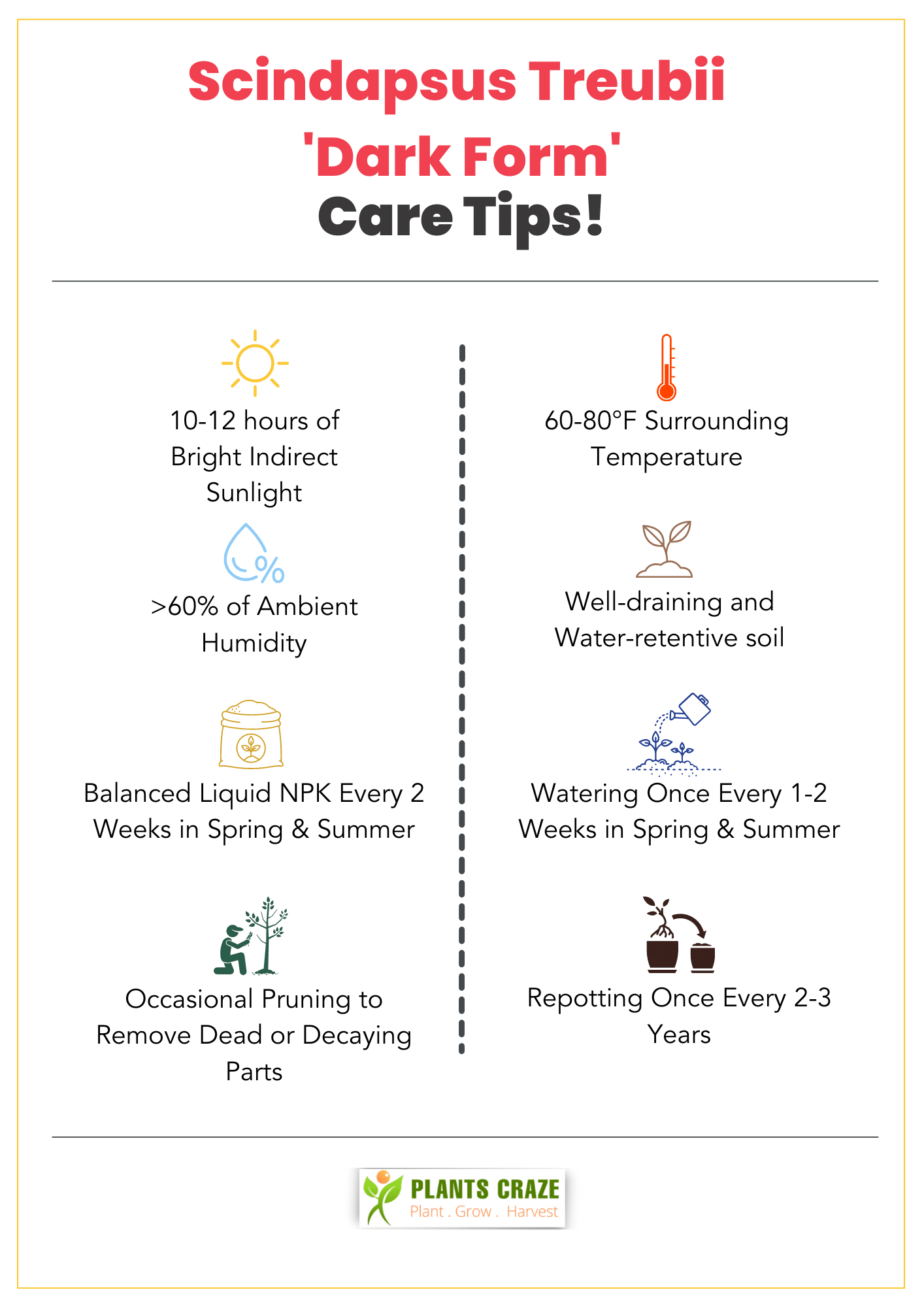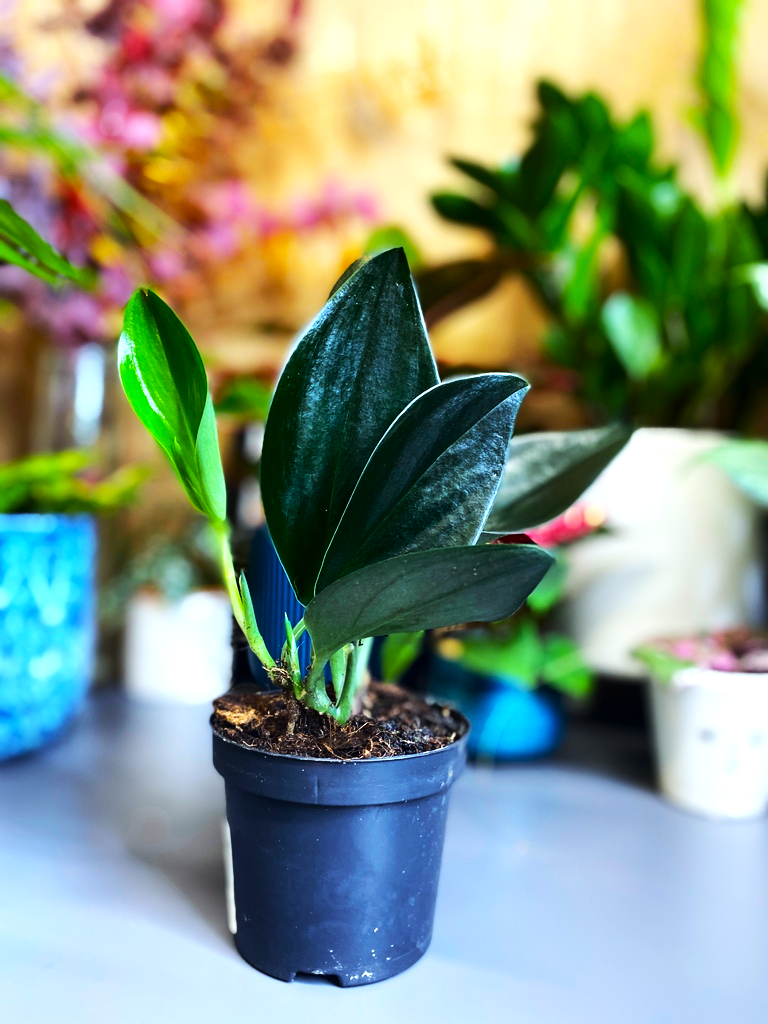The dark green leaves of Scindapsus Treubii ‘Dark Form’ get more pronounced with a push of nitrogen but backfires under improper fertilization.
Read on to discover the beginner-friendly yet most efficient care routine for Scindapsus Treubii ‘Dark Form.’
Table of Contents Show
Overview of Scindapsus Treubii ‘Dark Form’
Scindapsus Treubii ‘Dark Form’ is a species from the Araceae family characterized by a slow-growing climbing vine.
It boasts lance-shaped, glossy, dark green, or nearly black leaves and flowers on a spadix.
| Characteristics | Descriptions |
|---|---|
| Botanical Name | Scindapsus treubii ‘Dark Form’ |
| Common Name | Scindapsus treubii black, Scindapsus treubii dark, and Scindapsus nearly black |
| Family | Araceae |
| Genus | Scindapsus |
| Origin | Origianally form the rainforests of Southeast Asia, but can also be found in Pacific Islands and Queensland |
| Plant Type | Evergreen, perennial, tropical climbing vine |
| Growth Zone | 11B |
| Growth Size | 6 to 8 feet long and 1 to 3 feet wide |
| Grown For | Foliage |
| Foliage Type | Up to 20 inches long lance-shaped dark green to nearly black leaves |
| Blooms | Inflorescence flower born on a fleshly stalk Blooms during spring and summer |
| Toxicity | Toxic to both humans and pets |
| Maintenance Level | Easy to care |
Complete Care Guide for Scindapsus Treubii ‘Dark Form’
The forgiving nature of Scindapsus Treubii ‘Dark Form’ won’t be necessary if you succeed in mimicking their natural habitat-like condition.
They grow naturally in humid tropical rainforest jungles in Southeast Asia, Queensland, and New Guinea.

1. Light & Temperature
Scindapsus Treubii ‘Dark Form’ prefers 10-12 hours of bright indirect light daily with a warmth of 60-80°F.
Direct sunlight causes rapid transpiration causing Scindapsus to dehydrate faster, resulting in dry, curling, drooping leaves with brown leaf tips.
Likewise, severe low light and cold temperatures (<55°F) hinder growth and cause leggy, sparse foliage.
In such peril, aim for 8-12 hours of grow light, frost blankets, or heat pads to keep Scindapsus warm and healthy in winter.
Furthermore, if you are not from USDA 10 or above, move outdoor Treubii ‘Dark Form’ indoors to protect them from getting cold stress.
2. Water & Humidity
Scindapsus Treubii ‘Dark Form’ does not require frequent watering but prefers relatively high humidity (>60%).
Scindapsus’s thick, waxy leaves store moisture, making them more prone to get overwatered.
Yellowing, wilting leaves, and root rot are the common signs of excess water.
Meanwhile, underwatering and low humidity (<40%) introduce wrinkling, curling, and drooping Scindapsus leaves.
Thus, allow topsoil to dry out in between watering or use a moisture meter to ensure flawless watering.
Likewise, regularly mist the plant in the morning using spray bottles and employ a pebble tray underneath the pot.
3. Soil & Fertilizer
Provide Scindapsus Treubii ‘Dark Form’ well-draining, nutrient-rich soil with medium water retention then you are golden.
However, you must cut down fertilization in winter as they remain dormant with low nutrient uptake.
Overfertilization can choke the root, leading to rotting, which causes yellowing and drooping leaves with brown spots.
Meanwhile, nutrition deficiency causes curling, drooping, yellowing of foliage, stunted growth, leaf shrinkage, and smaller-sized new leaves.
Thus, regularly fertilize Scindapsus using organic composts and dilute fertilizers to dodge chemical burns.
Similarly, give phosphoric fertilizers in active blooming to encourage better flowering and thoroughly water after fertilization.
4. Potting and Repotting
Scindapsus Treubii ‘Dark Form’ prefers terracotta or clay planter that is 2-3 inches larger than the diameter of the rootball.
However, avoid plastic pots, as roots cannot breathe and water takes longer to dry out, causing root rot.
Scindapsus Treubii ‘Dark Form’ will show symptoms like stunted growth and drooping foliage with roots poking in case of root-bound.
Besides, plant infected with fungal problems like root rot needs immediate repotting to control further damage.
Proceed to repot the infected plant after carefully snipping away damaged parts and applying fungicides to the cut ends.
Remember to thoroughly soak the plant before repotting to lower transplant shock.
Note: The plant might appear wilted and drooped for a couple of days after repotting. But, do not worry as the plant revives naturally after it adapts to the new environment.
5. Occasional Pruning
Scindapsus Treubii ‘Dark Form’ is a slow grower, so they do not require regular pruning.
But they increase better when old, damaged, decaying, leggy foliage is regularly pruned away using sterilized pruners.
On top of that, pruning becomes pivotal when Scindapsus gets invaded by common pests from unfavorable conditions.
| Common Pests | Signs |
|---|---|
| Spider Mites | You can see yellow halo like structure in the foliage. Leaves appear speckled and later limp and wilt. |
| Scales | Honeydew sap sucking insects on surface or underside of leaves. |
| Mealy bugs | You can find white cotton like coating on the undersides of the leaves. |
If you notice such symptoms, prune off damaged parts and thoroughly apply neem oil or pesticide.
For regular pruning, aim for early spring to divert plant energy to new foliage growth while avoiding pruning in winter.
Scindapsus Treubii ‘Dark Form’: All About Growth
Scindapsus Treubii ‘Dark Form’ runs horizontally on the surface in the natural habitat.
However, Treubii ‘Dark Form’ climbs up when it finds a vertical surface, clasping the surface with its aerial roots.
The evergreen perennial climber Scindapsus proliferates actively in spring and summer but remains dormant in winter.

With ideal care, Scindapsus Treubii ‘Dark Form’ can grow 6-8 feet long with a 1-3 feet spread.
The juvenile leaves initially appear lush green and gradually become darker green.
On the other hand, it is very unlikely for indoor Scindapsus Treubii ‘Dark Form’ to produce flowers.
But in their natural habitat, Scindapsus produces inflorescence with a flashy greenish spadix.
Toxicity of Scindapsus Treubii ‘Dark Form’
Though Scindapsus Treubii ‘Dark Form’ seems beautiful with lustrous leaves, it can harm your furry friends.
According to the ASPCA, most aroids like Philodendrons, Scindapsus Treubii ‘Dark Form,’ and Scindapsus Treubii Moonlight are toxic to cats, dogs, and horses.
The plant contains calcium oxalate crystals, which are deemed to cause several alimentary and skin problems.
These toxic chemicals irritate surface contact, like skin and eye irritation on contact. Meanwhile, its other symptoms in humans include
- Swollen mouth, tongue, and lips
- Tingling sensation in the mouth
- Nausea leading to vomiting in severe case
- Stomach and alimentary canal irritation
Likewise, it causes drooling, pawing at the mouth, irritability, and vomiting in pets.
If you sense these symptoms in your pets or kids, seek help immediately.
Propagating Methods for Scindapsus Treubii ‘Dark Form’
Scindapsus Treubii ‘Dark Form’ can be propagated via stem cutting in spring and summer.
Moreover, you can choose whether to root the cutting directly in the soil or water.
Before hopping into the train of propagation steps, ensure you have rooting hormone, potting mix, a small pot, and a sterilized pruner.
- Inspect for a healthy stem with nodes and make a clean cut at a 45° angle right below the node.
- Ensure to leave one leaf and node intact with the cutting.
- Allow the cutting to form callus on the cut ends and apply to root hormone to encourage root growth.
- Rooting in Soil: Take a clean pot of about 2-3 inches and fill it with a well-draining mix.
- Plant the cutting in the soil mix and thoroughly water them.
- Keep the planted cutting in a humid, bright location.
- Rooting in Water: Directly submerge the cutting end in the glass jar filled with water and rooting hormone.
- Ensure the leaves are not touching the water.
- Change the water every 3-5 days to provide fresh water.
Generally, the cuttings will start sprouting roots within 4-6 weeks.
Once the cuttings have legit sturdy roots over an inch in length, consider transplanting them.
You can also propagate Scindapsus via seed germination, but it is complicated to harvest seeds from them.
Some Varieties of Scindapsus Treubii
Scindapsus Treubii has a wide variety of species that are stunning and peculiar. The types are generally similar in looks but are differentiated by the various shades.
1. Scindapsus Treubii Moonlight
Treubii Moonlight is one of the most popular varieties of Scindapsus among rare plant collectors.
They can be easily distinguished by their remarkable oval-shaped leaves with silvery-green shades.
Thanks to their silver glow, they are also called Scindapsus Treubii Silver or Sterling Silver.
2. Scindapsus Treubii Sumatra
The white or silver shades on the darker and slightly broad heart-shaped leaves are Scindapsus Treubii Sumatra’s distinguishing features.
The silvery vines of Treubii Sumatra look stunning when hung in a basket near a window or on a bookshelf.
3. Scindapsus Treubii Mint
It is one of the rare vine varieties of Scindapsus, adorned for its spectacular foliage with marbled mint variegation or marbled tint in the leaves.
Scindapsus Treubii Mint resembles pothos as its leaves and vining nature is similar.
However, the variegation of this species is slightly lighter and looks much like that of Scindapsus Treubii Moonlight.
Scindapsus Treubii ‘Dark Form’: Plant on Sale
One of the rare Scindapsus species, Treubii ‘Dark Form,’ often baffles plant parents due to their similar appearance to Epipremnum plants.
Thus, be careful while buying Treubii ‘Dark Form’ as many scammers are online, ready to scam you immediately.
| Places to Buy | Delivery Time |
|---|---|
| Etsy | 3 to 7 business days |
| Plant Circle | 1-3 business days |
| Aroid Market | 4 to 7 business days |
| Tropics At Home. | 2-8 business days |
FAQs about Scindapsus Treubii ‘Dark Form’
What is the difference between Scindapsus Treubii ‘Dark Form’ and Moonlight?
Scindapsus Moonlight has oval-shaped, silvery-green patterned leaves, while ‘Dark Form’ has dark green teardrop or lanceolate leaves.
Is Scindapsus Treubii ‘Dark Form’ rare?
Scindapsus Treubii ‘Dark Form’ is a rare variety with aesthetic dark green leaves that look almost black.
From Editorial Team
Rare But Easy-to-Care For!
Though rare, Scindapsus Treubii ‘Dark Form’ is an evergreen perennial that is beginner-friendly.
Place them in highly humid places like the kitchen and bathroom, ensuring optimal indirect bright light and average indoor warmth temperature.
Happy Gardening!


